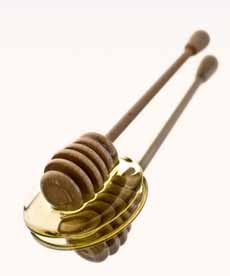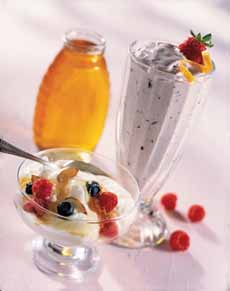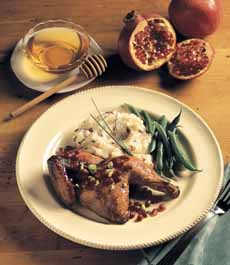
[1] Depending on the flower pollen, honey is available in many colors, from palest yellow (fireweed honey) to almost black (buckwheat honey) (photo courtesy National Honey Board).

[2] The simple solution to messy, drippy honey: a honey swirler (photo Hannah Kaminsky | Bittersweet Blog).

[3] Yogurt and smoothie with honey (photo courtesy National Honey Board).

[3] Pan-seared salmon with honey glaze (photo courtesy National Honey Board).

[4] Roast duck with honey glaze (photo courtesy National Honey Board). |
|
September is National Honey Month. Whether used straight as a sweetener in a cup of tea, or as an ingredient in endless recipes, honey is a hero: an all natural energy booster.
Look for raw or unrefined honey, in varietals: acacia, blueberry, clover, lavender, orange blossom, sage, wildflower—there are hundreds of different varieties around the world.
We avoid generic honey, the type simply labeled “honey” at the supermarket. It is a blend of cheap honeys, often from countries like Argentina and China that specialize in providing cheap honey.
These honeys provide sweetness, but that’s it: none of the nuances of flavor from the different flowers (a varietal honey is one particular variety of flower).
Another reason to buy varietal honey: Honey is one of the most adulterated foods on Earth—many companies mix it with cheaper sweeteners like sugar and corn syrup to cut costs. Look for “pure honey” on the ingredient label—and skip anything that lists “honey blend” as an ingredient.
Use different types to change the taste in recipes. In general, the darker the honey, the stronger the taste and the higher the antioxidant content. If you can find a honey sampler with one- or two-ounce jars, grab it. Then spend some time with a spoon, tasting the honey from the jars and noting the differences.
There are many recipes that use honey, from Honey Glazed Chicken and Honey Glazed Carrots to breakfast breads. You can substitute honey for table sugar and brown sugar in any recipe.
But there’s no cooking required for these tasty uses for honey:
BEVERAGES WITH HONEY
Use instead of sugar or simple syrup in:
Cocktails.
Honey milk. Add a spoon of honey to a glass of milk as an alternative to chocolate milk.
Tea: hot and iced.
Smoothies.
BREAKFAST FOODS WITH HONEY
Broiled grapefruit. This oldie is a goodie: Drizzle honey on grapefruit halves. Brown it under the broiler (or eat it without broiling).
Cereal. Use instead of sugar to sweeten cereal and porridge.
Cut fruit. Drizzle on fruit that lacks natural sweetness.
Jam substitute. Honey is a nutritious alternative to jam and preserves.
Honey Butter. Delicious on breakfast breads and pancakes, simply blend one stick (4 ounces) of room-temperature butter with 3 to 4 tablespoons of honey.
Honey yogurt. Mix into plain yogurt. Add chopped basil, mint or rosemary for more dimension of flavor. You can do the same with cottage cheese and ricotta.
Maple syrup substitute. For pancakes, waffles and French toast.
Muffins. Brush honey freshly baked muffins for a quick glaze, or brush room temperature muffins and give them 5 seconds in the microwave.
Peanut butter or other nut butter on toast or rice crackers, drizzled with honey.
DESSERTS WITH HONEY
Cake filling. Whipping 2 cups of low-fat ricotta or whipped cream cheese in a food processor with 4 tablespoons of honey and a pinch of ground cinnamon. Stir in ¼ cup of chopped crystallized ginger, mini chocolate chips or 1 tablespoon lemon or orange zest.
Custard. Substitute honey for sugar in custard, flan, panna cotta.
Light frosting. Blending 12 ounces of room-temperature whipped cream cheese with ? cup of honey, the grated zest of an orange and a pinch of salt.
Topping for ice cream.
Topping for un-iced cakes.
SPREADS, SAUCES & DIPS WITH HONEY
Start with the lower amount of honey, and add more to taste.
Barbecue Sauce. Blend= ¼ to ? cup of honey into 1 small can (6 ounces) of tomato paste. Add 1 to 2 teaspoons of prepared mustard and season with Worcestershire or soy sauce to taste. Thin with water, if necessary.
Honey mustard. Combine Dijon and honey in a 2:1 proportion. Taste and add more honey as desired.
Honey mustard mayo spread. Make a sandwich spread with 4 tablespoons (1/4 cup), 1 tablespoon honey and 1 tablespoon mayonnaise.
Peanut sauce or dip. Thinning peanut butter with a little hot water or broth, sweeten with honey taste, flavor with soy sauce and red chile flakes to taste.
Vinaigrette. Combine 2 tablespoons wine vinegar, 6 tablespoons olive oil, 1 tablespoon honey and 1 tablespoon Dijon mustard. Option: Add 1/4 teaspoon minced garlic.
|
|
OTHER FAVORITE USES FOR HONEY
Baked beans. Use honey instead of sugar in the recipe; or half honey, half brown sugar. (Tip: Most recipes have too much sweetener. Use half or two-thirds of what is called for.
Cheese condiment. With all cheeses, from the mildest ricotta and goat to aged parmesan and Gouda.
Energy boost. Have a teaspoon from the jar. Unlike sugar, honey is a nutritious carbohydrate that provides immediate energy. If you don’t want to eat it directly, add it to a cup of warm water mixed with lemon, or a cup of tea (no milk), or on a slice of apple or banana.
Peanut butter and honey sandwich. More sophisticated than PB&J.
HONEY NUTRITION
Honey is a nutritional powerhouse.
Minerals: calcium, iron, copper, phosphate, sodium chlorine, magnesium, manganese and potassium.
Vitamins: B6, niacin (B3), riboflavin (B2), thiamin (B1), pantothenic acid (B5).
Plus: amino acids and antioxdants.
MORE HONEY INFORMATION
Certified Organic Honey & Raw Honey
Honey Varietals: The Different Types Of Honey
Forms Of Honey
The History Of Honey
Honey Facts
Pairing Honey With Foods & Beverages
Storing & Using Honey
|




